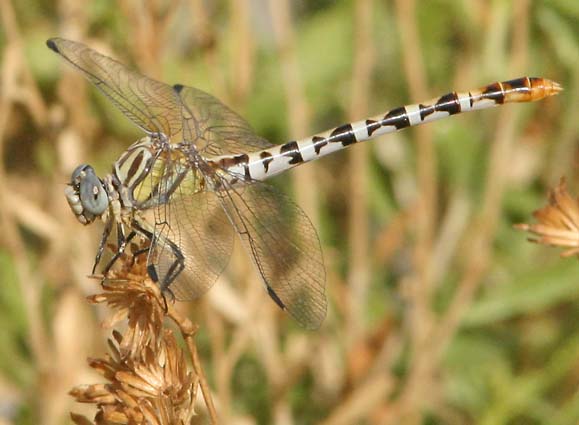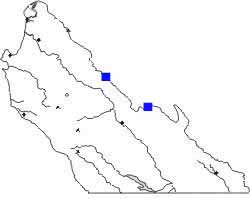| |
|
|
|
WHITE-BELTED
RINGTAIL
|
|
Erpetogomphus
compositus
|
|
|
|
 On 7 Aug 2002, Paul Johnson saw a White-belted Ringtail
along the extreme western edge of Pinnacles National Monument. It was
along a trail in chaparral. The species was a known resident along
creeks in Pinnacles NM, but nearly all of the park is within San Benito
County. This one was, by luck, in Monterey County, and remained the
sole county record for 5 years. It has been one of only two species to
be on the county checklist by a sight record only. On 7 Aug 2002, Paul Johnson saw a White-belted Ringtail
along the extreme western edge of Pinnacles National Monument. It was
along a trail in chaparral. The species was a known resident along
creeks in Pinnacles NM, but nearly all of the park is within San Benito
County. This one was, by luck, in Monterey County, and remained the
sole county record for 5 years. It has been one of only two species to
be on the county checklist by a sight record only.
On 25 Aug 2007, Paul Johnson & Don Roberson
explored a stretch of the San Lorenzo River, on the MTY/SBT border east
of King City (right). Most of this river runs through private land, but
permission was obtained. Male Ringtails like to sit on rocks in streams
through arid country, and at least 10 males were found doing just that
in a quarter-mile stretch of the San Lorenzo (photo above & below).
This time several were photographed. It is apparent the species is also
regular here, at least in late August.
|
|
|
|
 Manolis (2003) says that it this
is "a striking dragonfly that looks like a colorful composite of
different species." Indeed, its Latin species name (compositus)
refers to that very fact. It was a striking clubbed 'tail' (tip to
abdomen) which is bright orange; a pattern of black and white rings
around the rest of the abdomen, and a complex pattern of yellow, brown,
and white on the thorax. The word "white-belted" in its English name
refers to the thoracic pattern (see below). Manolis (2003) says that it this
is "a striking dragonfly that looks like a colorful composite of
different species." Indeed, its Latin species name (compositus)
refers to that very fact. It was a striking clubbed 'tail' (tip to
abdomen) which is bright orange; a pattern of black and white rings
around the rest of the abdomen, and a complex pattern of yellow, brown,
and white on the thorax. The word "white-belted" in its English name
refers to the thoracic pattern (see below).
All photos to here 25 Aug 2007 San
Lorenzo River © D. Roberson
|
|
 Female White-belted
Ringtail is patterned rather like the male, but the tip of
abdomen is not expanded (right). No female has yet been found in MTY,
but (of course) they do occur and should be looked for, but typically
away from the stream. The males patrol the streams, chasing other males
(and females when they arrive), and posing conspicuously on rocks or
other similar perches. Female White-belted
Ringtail is patterned rather like the male, but the tip of
abdomen is not expanded (right). No female has yet been found in MTY,
but (of course) they do occur and should be looked for, but typically
away from the stream. The males patrol the streams, chasing other males
(and females when they arrive), and posing conspicuously on rocks or
other similar perches.
Photo 27 May 2007 Dos Palmas
Preserve, Riverside Co. © D. Roberson
|
|
 The map shows the only two known location for
White-belted Ringtail in MTY to date: both were along the very
easternmost edge of the county in August. This species occurs widely
along sandy or gravel-bottomed streams in the arid foothills, valleys,
and deserts of California. It likely occurs in such habitats elsewhere
in MTY, especially late in the summer, but there are few such streams
in MTY. The map shows the only two known location for
White-belted Ringtail in MTY to date: both were along the very
easternmost edge of the county in August. This species occurs widely
along sandy or gravel-bottomed streams in the arid foothills, valleys,
and deserts of California. It likely occurs in such habitats elsewhere
in MTY, especially late in the summer, but there are few such streams
in MTY.
MTY dates so far are between 7–25 August.
Elsewhere in California, this species has a flight season ranging from
April to October (Manolis 2003).
|
|
|
|
|
The photos above compare White-belted
Ringtail (above left) with Serpent Ringtail (above
right) Erpetogomphus lampropeltis of the nominate subspecies (E.
l. lampropeltis). This subspecies is quite different than Serpent
Ringtails in the southwestern U.S. and Mexico. It occurs in the coastal
mountains of southern California, where it is a field identification
problem versus White-belted Ringtail. To date Serpent Ringtail is known
in California only north to Santa Barbara County, but it is possible
that this species might occur in the southern Santa Lucia Mountains of
Monterey County where, to date, no ringtails have been found.
In
comparing the two ringtails, note that
White-belted usually has a much more conspicuous orange tip to the
clubbed
abdomen; the orange on Serpent Ringtail is typically darker and the top
of
abdomen segments 7-10 is much darker, almost blackish, on Serpent.
There can be overlap at the extremes between the "tail" patterns of
ringtails, so use that feature in connection with other features. For
example, White-belted has much more white at the base of the abdomen,
and the white and black abdominal rings are about equally dominant. On
Serpent, the black abdominal rings are dominate.
The term "White-belted" refers to white
'belts' within the brown thoracic patches on White-belted Ringtail
(below left). Note that the yellow patches on the thorax are separated
by big brown patches, each of which has an internal white stripe (or
'belt'). On Serpent Ringtail (below right) the yellow patches are
reduced, but the brown patches are much more prominent, with only a few
small irregular white spots or dots internally. This is especially
apparent on the anterior brown side patch. There are also difference in
the amount of dark and white on the legs (as shown in the comparisons
below), and the blue eyes of White-belted tend to be paler and purer
blue than the gray-blue eyes of Serpent Ringtail. There are also
differences in the male appendages (see Manolis 2003).
|
|
|
|
|
Photo (above green
box, left) 25 Aug 2007 San Lorenzo R. MTY
Photo (above green box, right) 16 Aug 20067 Frenchmans Flat, Piru
Creek, Los Angeles Co.
Photo (just above,
left) 3 Aug 2007 west of Calexico, Imperial Co.
Photo (just above, right) 16 Aug 20067 Frenchmans Flat, Piru Creek, Los
Angeles Co.
|
|
Literature cited:
- Manolis, T. 2003. Dragonflies and Damselflies of
California. Univ. of
Calif.
Press, Berkeley.
Web resources:
Major identification web sites with much information on California
odes include:
For sites with excellent photos to compare for identification or to
simply
enjoy, see:
Many of these sites have links to other useful pages. Kathy Biggs's
site
is particularly useful in her selection of links. |
|
All photos © Don Roberson 2007
TOP
|
|
|
Page created 8 Mar 2007,
updated 26 Aug 2007
|
|
|
|
|
